
12 Major Differences Between The “Paper Girls” Show And Comics
? WARNING: this post contains major spoilers for Paper Girls Season 1 as well as the comics! ?
Paper Girls is a new series on Prime Video based on the popular comics by Brian K. Vaughn and Cliff Chiang.
 Prime Video
Prime VideoIn the show, all four girls wind up in 2019 and then 1999. While they split into various groups when they arrive in each year, they tend to stick together on the whole and it’s not until the end of Season 1 they accidentally get separated and wind up in, presumably, totally different time periods — with Tiff and Erin in the ’50s and KJ and Mac in an undisclosed time.
The comics show the girls traveling to 2016 and 2000 (not to mention a bunch of other time periods — but they may yet show up in Season 2), and they also tend to get separated a little more than they do in the show.
2. Mac’s family play larger roles.
 Prime Video
Prime VideoIn the comics, Mac’s older brother Dylan has a very brief role as a bit of a jerk in 1988, while Alice is seen at Mac’s house after the initial invasion happens on Hell Day, where she’s freaking out and tries to shoot herself. Mac struggles with Alice and the gun, which is how it goes off, and accidentally shoots Erin. This is different from the show, where Alice isn’t seen after the invasion begins (until the 2019 timeline) and Mac is trying to hold onto the gun when it goes off and shoots Erin.
Dylan, meanwhile, has a much bigger part in the show. Instead of Mac going to her old house in the future and finding a stranger living there — who then tells her the daughter of the former occupants died of cancer — Mac in the show finds her house demolished, and hunts down her brother at a hospital where he works as a doctor. It’s Dylan who informs her she died of cancer. He then takes her home, and the two of them spend some quality time together before Mac is forced to leave in order to protect Dylan. None of this happens in the comics.
3. The monsters have been reduced in the show.
 Prime Video
Prime VideoIn the comics, the old timers use dinosaurs from the very start, and we also see other kinds of weird monsters throughout the series. Plus, there are a whole bunch of giant robots fighting at one point, although only Tiffany can see them.
In the show, we just get to see two giant robots — one of which the girls and adult Erin get to go inside — and one dinosaur, which doesn’t appear until the end of the season.
4. Adult Erin isn’t quite so miserable.
 Prime Video
Prime VideoIn the show, the girls find adult Erin when they go to Erin’s house and discover they’ve time traveled. Erin is bitterly disappointed with how the adult version of herself has turned out. She lives in her childhood home after her mother’s death is a paralegal, and doesn’t really talk to her sister, Missy.
In the comics, adult Erin comes across the girls while driving, after they already know they’ve time traveled. Young Erin is much kinder to her adult self, who is a journalist, still gets on with her sister, and has a mother that is still alive.
Oh, and adult Erin doesn’t die in the comics!
5. Adult Tiffany is on a different journey.
 Prime Video
Prime VideoAdult Tiffany is also different from her comic counterpart. In the comics, she doesn’t go to MIT, but to NYU’s Stern School of Business, and she ends up married to a goth guy named Chris. One thing the two different versions of her have in common is they’re both kind of drifting through life in a way that disappoints young Tiffany, but the show version of adult Tiffany dropped out of MIT and has started her own institute. Her work at the institute will see her play a huge role in inventing time travel — whereas, in the comics, time travel is invented by an entirely different character, Dr. Braunstein (who may pop up in the show if it gets a Season 2).
Show Tiffany is also not married to Chris, instead, she’s in a dead-end relationship with a skater named Russ.
6. There’s no Larry or Juniper in the comics.
 Prime Video
Prime VideoProbably the biggest change to the show from the comics is the addition of Larry and Juniper — particularly Larry. He plays a huge role in the show as a member of the STF who helps the girls before betraying them, causing adult Erin’s death. Juniper is another STF member who Larry seems to be in love with.
In the comics, neither of these characters exist. There is another character who the girls learn more about time travel from, who may appear in future seasons.
7. Prioress has a bigger role in the show.
 Prime Video
Prime VideoIn the comics, Prioress has a relatively minor role before being killed. Her death devastates the Grand Father and serves as motivation for him to want to hunt and destroy the paper girls.
In the show, Prioress is on a revenge mission herself after the girls kill her brother, and spends the season hunting them across time. At the end of the season she has a change of heart, and she helps the girls escape the Grand Father, sending them off on a mission to put an end to the time war once and for all. She’s hurt in the process, and while the girls try to save her, the Grand Father leaves her to die.
8. KJ kills a different person.
 Prime Video
Prime VideoIn the show, KJ kills Prioress’ brother. In the comics, she kills a man when the group travel back to 11706 BCE — something we didn’t see in the show, but which may appear in future seasons.
9. There are no clones in the show.
 Prime Video
Prime VideoA major plot point of the comics is the fact that some of the girls get cloned by the STF (although they’re not called that in the comics). We see several versions of Erin, and another KJ. One of the Erins is actually the person who scatters the girls across time after begging them to put an end to the time war — a plot point taken over by Prioress on the show.
10. KJ gets her period in the comics, not Erin.
 Prime Video
Prime VideoErin getting her period is a big moment in the show. She’s the first of the girls to get hers, and Mac helps her steal some sanitary products, as the girls are stranded in 2019 when it happens.
In the comics, it’s actually KJ who gets her period, and it’s worse luck for her — it happens when the girls are stuck in 11706 BCE.
11. KJ confronts her sexuality in a different way.
 Prime Video
Prime VideoIn the comics, KJ sees a vision of herself kissing Mac, and that is how she begins to explore her sexuality.
In the show, it’s clear KJ is drawn to Mac, but it’s actually by seeing her adult self (who doesn’t appear in the comics) kissing her girlfriend that KJ has the realization that she’s queer. KJ’s interactions with her future girlfriend — and the fact that she becomes a film student — were all invented for the show.
12. Wari and baby Jahpo are not in the show.
 Prime Video
Prime VideoWhen the girls travel back to 11706 BCE in the comics, they meet a girl named Wari, who has a baby named Jahpo. Both characters play a huge role in the plot overall, and neither have appeared in the show (although we’ve seen who the older version of Jahpo is in the comics — it’s unclear if the show will follow the same plot).




































